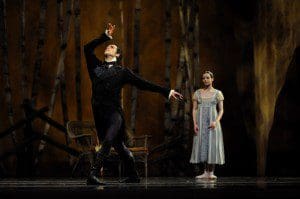
Often, the thing we love about the work of a great author is the ability to describe a moment, an emotion, some nuance of experience, in such a way that it is immediately recognizable to us, however foreign to our experience it actually is. We feel they somehow rummaged around in our mind and conveyed our lives back to us with different plots and more elegant language. The months after I graduated from college and was struggling to find work, feeling like I was both fabulous and doomed to uselessness, was probably the worst time to read The House of Mirth. And who would not recognize his own moments of mortified infatuation in Tolstoy’s description of Levin: “He avoided long looks at her as one avoids long looks at the sun; but he saw her, as one sees the sun, without looking.”
Ballet can elicit the same recognition: it doesn’t matter that most of us are too stiff, short-limbed, paunchy, or weak to even think without strain of the movements we see performed. Though we speak a different language, we can “read” dance and transcribe its expressions as our own. In Kenneth MacMillan’s “Romeo and Juliet,” when Romeo has left Juliet’s bedroom and fled the city, she pulls the window curtain aside, arches her back, thrusting her chest toward the dawn light streaming into her room. Somehow, we know she is asking the gods to assist her in her helpless, entirely vulnerable state, that this is the physical manifestation of heartfelt entreaty. Though dancers portray human experience in a way that most people couldn’t and wouldn’t do themselves, they are able to evoke sympathetic experiences through their movements; we (ballet lovers, at least) watch and think, “Yes, this is what love/lust/fear/jealousy/etc. looks like,” and momentarily, feel it along with them.
But there are limitations. A story like Romeo and Juliet’s is ideal for translation through movement; the emotions are extreme, the characters’ actions are driven by those emotions rather than by complicated intellectual calculations, and the plot, is easy to follow.
Pushkin’s Eugene Onegin, adapted and choreographed into “Onegin” by 20th century great John Cranko, is not quite as simple, and its nuances are often missed or coarsened, possibly in the interest of facility. I won’t relay the plot here, but rather point out the most common flaw in many interpretations of the work, which is that Onegin is erroneously, boringly, portrayed as a cad, simply because he doesn’t return Tatyana’s declared love for him on cue. For the time and society in which EO takes place, a man of the world, as Onegin is described, would have been ostracized as a seducer if he accepted a naïve girl’s offering of herself. It’s what Pride and Prejudice‘s Wickham does with Lydia, for which that character is rightly acknowledged as reprehensible. But Tatyana casts such a spell on all artists and audiences alike that for Onegin to reject her, even gently, as he does in the book, is regarded as a character flaw rather than the necessary submission to duty that it is. He is vilified by interpreters for having the honor to turn her down, and even for failing to fall in love with her as immediately and completely as she does with him.
Cranko’s 1965 ballet, which was recently performed by the San Francisco Ballet, succumbs to this misinterpretation. Onegin acts with baseless cruelty toward Tatyana, such as when he rips up her letter at her name-day celebration and throws the pieces to the ground. And he is costumed all in black, emphasizing visually that he’s a “bad guy.” Onegin’s treatment of Lensky is terrible (and his indirect treatment of Tatyana through his behavior at her party is as well). But it seems like that was a terrible, stupid thing that an otherwise conscientious person did, rather than a terrible, stupid thing that a habitually terrible person did. Onegin’s an upstanding guy—Pushkin points out in nearly every one of the hero’s meetings with Tatyana, that he takes great pains to be kind–but he fails, and there’s great drama in that. It’s not dramatic, or faithful to the book, to take Onegin’s treatment of Lensky and color his entire character with it. Why should we be interested in a uniformly loathsome character?
Altering a story to “read” better through movement is one thing. (This was exhibited brilliantly at several points, for instance when Tatyana’s famous solitary “letter scene” transforms into a pas de deux between her and the imaginary Onegin she writes to.) But to flatten a complex character into a cartoon villain does injustice both to Pushkin’s story and to an audience capable of appreciating something more morally nuanced than, well, most narrative ballets. Ballet’s stories so often are populated with ruined virgins, wicked sorcerers, and fairytale princesses, possibly because the human experiences – and highly emotional stories — they have to communicate find obvious expression through the body.
But the aspects of the Onegin story on which the plot and the destinies of its characters hinge are not strictly emotional: Onegin’s initial rebuke of Tatyana does not have to do with hatred, or even dislike. Perhaps he does not reciprocate her infatuation, but even this is not what motivates him. She has thrown herself at him, and so he must do the honorable thing.
Read more from Larissa Archer at her blog, larissaarcher.com.

One thought on “How Do You Dance ‘Honor’?: SF Ballet’s ‘Onegin’ by John Cranko”